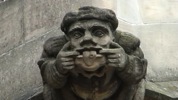It’s Risjaar de modderfokker this week. That speech opening the play on a London street is a killer talking about how good it feels to be a killer. Unashamed evil portrayed friendly-like as with those others Iago, Aaron, Edmund. These characters are the mirrors of the dark side of the soul. We could put them […]
|
||||||
|
‘I hope to show clearly and convincingly that the answer is to be found in the patent fact that human beings possess in varying degrees a certain natural faculty or power or capacity which serves at once to give them their appropriate dignity as human beings and to discriminate them, not only from the minerals […] Now that’s a catchy title designed to make you rush to read it. But it has to do with my own obsession with lists. The tabling of knowledge in a seeming order with a logical overview: to get the whole at a glance. Roget’s Plan of Classification for his Thesaurus is probably one of the […] The stock characters are a group of seven around whom you can build a play at any moment. They are widely used for the standard reactions they elicit: 1) A young lover…A young person in love for the very first time. 2) An old miser…a niggard in youth, a miser in old age. 3) A […] Here are 8 drunken stereotypes by Thomas Nashe from the Elizabethan era. I wonder what type of drunk our WIll would have been. In the poem ‘Pete the Parrot and Shakespeare’, found under the Sh. poems page on this site, he is a maudlin drunk: APE drunk- leaps and hollers, sings and dances for […] I’m off to see Ben in Titus Andronicus at the Globe. Apparently it’s a cover up. Titus is basically the Dawn of the Dead for Elizabethan audiences. Goths without the black make-up and perfume. Maybe it was an early morality play, what with the uncle finding his niece freshly de-tongued to tell and armless to […] The absorbing problem of the renaissance was knowledge of one’s self. Individual self-hood was gaining popular ground now that the church was no longer the ultimate arbiter of right and wrong. Interestingly the personal pronouns of myself and your self were more often two seperate words and not yet one! The Greeks in particular Aristotle, […] Words by Adam MacNaughton Music: The Mason’s Apron There was this king sittin in his gairden aw alane When his brother in his ear poured a wee tait o henbane Then he stole his brother’s crown and his money and his widow But the deid king walked and got his son and said, Hey listen […] There are five steps to rhetoric. 1) Inventio – ( Heuresis in greek) The search and discovery of arguments by reference to topic or categories: Cause and effect Similarity or difference The possible vs. the impossible The authority of precedents. 2) Disputio – ( Taxis ) The method of organizing one`s material: Exordium or the […] *The Elizabethan titles of dignity for the perenially confused are in descending order of Nobility: King and Queen: addressed as Sir, Madam, or Your Majesty. Duke and Duchess: addressed as his/her Grace the Duke of etc., your Grace, or Sir. Marquess and Marchioness: addressed as my Lord and Lady. Earl (Count) and Countess: addressed as […] |
Look and Listen to OthersOnline Works of Shakespeare
Play SchoolRenaissance School
Scholarly Renaissance-related blogsShakespeare Blogs
Shakespeare Institutions
Shakespeare or SOMEONE ELSE?
Sonnet School
|
|||||
|
Copyright © 2025 I Love Shakespeare - All Rights Reserved Powered by WordPress & Atahualpa |
||||||
